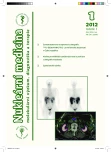Quality of stress tests performed for myocardial perfusion scintigraphy
Authors:
Ivana Kuníková; Otto Lang; Hana Syslová
Authors‘ workplace:
3. lékařská fakulta UK a FN Královské Vinohrady, Praha
Published in:
NuklMed 2012;1:13-16
Category:
Original Article
Overview
Introduction:
Appropriate performance of stress test is crucial for a quality of reports of a stress myocardial perfusion scintigraphy.
Purpose:
Retrospective analysis of stress tests quality performed in our department in the years 2007-2009.
Methods:
Stress test could be performed in different forms. Physical stress is the most physiological. Pharmacological (in the Czech dipyridamole or dobutamine) or combined stress could be used when physical stress is inappropriate. Unless no angina occurs, physical stress is considered adequate if the patient achieves more than 85 % of maximal age-predicted heart rate (MPHR) or double-product above 25 000.
Results:
We analyzed 1189 patients (629 females, 560 males), average age of 62,5 (24-88) y referred for stress myocardial perfusion imaging. We used following types of stress: physical only in 687 (58 %), dipyridamole in 73 (6 %), dipyridamole with physical stress in 418 (35 %), and dobutamine in 10 (1 %) patients. Required heart rate was achieved in 626 (91 %) patients stressed with physical activity. Patients who did not achieve required heart rate fulfilled adequate double-product in 41 cases, angina occurred in 8 patients, 8 patients achieved 75 % of MPHR (myocardial infarction in the history) and others were symptom limited (and simultaneously contraindicated to pharmacological stress).
Conclusion:
Absolute majority of our patients were stressed adequately, so we do not produce false negative reports.
Key words:
stress test, myocardial perfusion scintigraphy, physical stress, heart rate
Sources
1. ASNC Imaging guidelines for nuclear cardiology procedures [online]. 2009. [cit. 2011-09-26]. Dostupné na: http://www.asnc.org/imageuploads/ImagingGuidelinesStressProtocols021109.pdf
2. Lang O, Kamínek M, Trojanová H. Nukleární kardiologie. Praha, Galén, 2008, 130 s
3. Mysliveček M, Kamínek M. Doporučení k provádění zátěžových testů v nukleární kardiologii. Cor et Vasa 2000;42:K54-K56
4. Národní radiologické standardy: diagnostické a léčebné metody nukleární medicíny [online]. 2005. [cit. 2011-05-22]. Dostupné na: http://www.csnm.cz/files/spolecnost/nrs/navrh_NRS_2005.pdf
5. Hradec J, Bultas J, Želízko M. Stabilní angina pectoris – doporučený diagnostický a léčebný postup České kardiologické společnosti. Cor et Vasa 2010;52:543-561
6. Kupka K, Kubinyi J, Šámal M et al. Nukleární medicína. Plzeň, P3K, 2007, 204 s
7. Kamínek M, Metelková I, Budíková M, Lang O. Pokroky v zobrazování perfuze a funkce levé srdeční komory jednofotonovou emisní tomografií. Cor et Vasa 2010;52:513-522
8. Mettler FA Jr, Guiberteau MJ. Esentials of nuclear medicine imaging.4th edition. Philadelphia, W.B.Saunders Company, 1998, 470 p
9. EANM/ESC procedural guidelines for myocardial perfusion imaging in nuclear cardiology [online]. 2005. [cit. 2011-09-26]. Dostupné na: http://www.eanm.org/scientific_info/guidelines/guidelines_intro.php
10. Myocardial Perfusion Imaging – A Technologist´s Guide. Vienna, European Association of Nuclear Medicine, Technologist Committee and Technologist Education Subcommittee, 2004, 48 p
Labels
Nuclear medicine Radiodiagnostics RadiotherapyArticle was published in
Nuclear Medicine

2012 Issue 1
Most read in this issue
- Somatostatin receptor scintigraphy - 99mTc-EDDA/HYNIC-TOC first clinical experience in the Czech Republic
- Neuroendocrine tumors
- Stress tests in nuclear cardiology
- Quality of stress tests performed for myocardial perfusion scintigraphy
